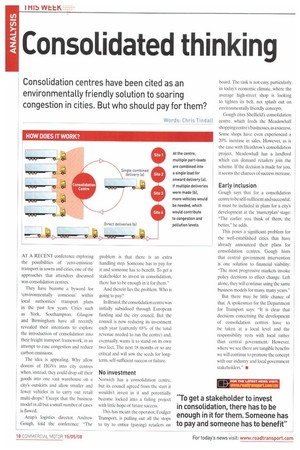Consolidated thinking
Page 18

If you've noticed an error in this article please click here to report it so we can fix it.
Consolidation centres have been cited as an environmentally friendly solution to soaring congestion in cities. But who should pay for them?
Words: Chris Tindatt Al' A RECENT conference exploring the possibilities of 'zero-emission' transport in towns and cities, one of the approaches that attendees discussed was consolidation centres.
They have become a byword for 'environmentally conscious' within local authorities' transport plans in the past few years. Cities such as York, Southampton, Glasgow and Birmingham have all recently revealed their intentions to explore the introduction of consolidation into their freight transport framework, in an attempt to ease congestion and reduce carbon emissions.
The idea is appealing. Why allow dozens of HGVs into city centres when, instead, they could drop off their goods into one vast warehouse on a city's outskirts and allow smaller and fewer vehicles in to carry out retail multi-drops? Except that the business model in all but a small number of cases is flawed.
Arup's logistics director, Andrew Gough, told the conference: -The problem is that there is an extra handling step. Someone has to pay for it and someone has to benefit. To get a stakeholder to invest in consolidation, there has to be enough in it for them."
And therein lies the problem. Who is going to pay?
In Bristol, the consolidation centre was initially subsidised through European funding and the city council. But the council is now reducing its investment each year (currently 65% of the total revenue needed to run the centre) and, eventually, wants it to stand on its own two feet. The next 18 months or so are critical and will sow the seeds for longterm, self-sufficient success or failure.
No investment
Norwich has a consolidation centre, but its council agreed from the start it wouldn't invest in it and potentially become locked into a failing project with little hope of future success.
This has meant the operator, Foulger Transport, is pulling out all the stops to try to entice (paying) retailers on board. The task is not easy, particularly in today's economic climate, where the average high-street shop is looking to tighten its belt, not splash out on environmentally friendly concepts.
Gough cites Sheffield's consolidation centre, which feeds the Meadowhall shopping centre's businesses, as a success. Some shops have even experienced a 20% increase in sales. However, as is the case with Heathrow's consolidation project. Meadowhall has a landlord which can demand retailers join the scheme. If the decision is made for you, it seems the chances of success increase.
Early inclusion
Gough says that for a consolidation centre to be self-sufficient and successful, it must be included in plans for a city's development at the 'masterplan' stage: "The earlier you think of them, the better," he adds.
This poses a significant problem for the well-established cities that have already announced their plans for consolidation centres. Gough hints that central government intervention is one solution to financial viability: "The most progressive markets invoke policy decisions to effect change. Left alone, they will continue using the same business models for many, many years."
But there may be little chance of that. A spokesman for the Department for Transport says: "It is clear that decisions concerning the development of consolidation centres have to be taken at a local level and the responsibility rests with local rather than central government. However, where we see there are tangible benefits we will continue to promote the concept with our industry and local government stakeholders." •




























































































































































































